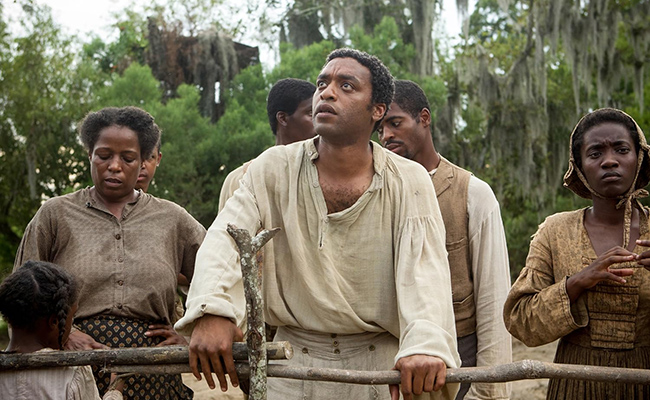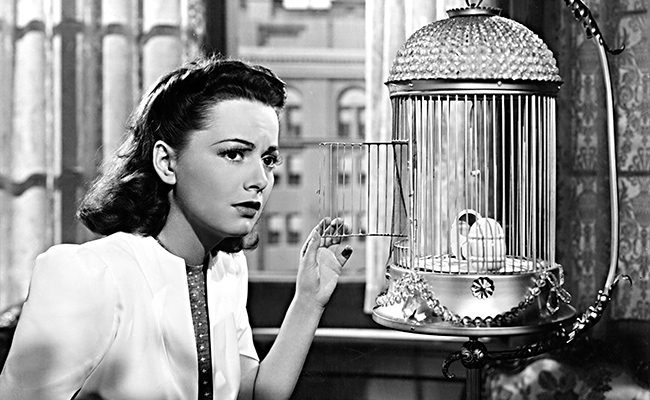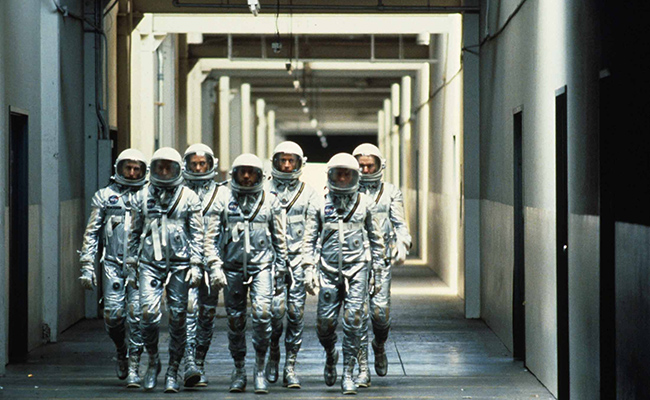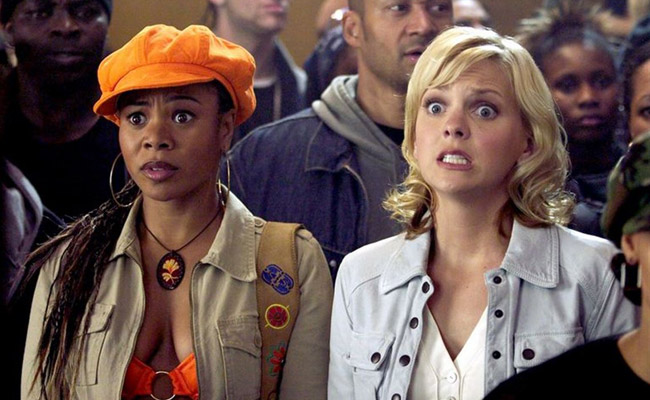
Fox Searchlight Pictures
Many notable films were released this week across the past century, with several garnering awards nominations and wins, including one Best Picture winner among the group. Several of the 1923 silents are still in existence, while a film from 1933 gave James Cagney a new persona and became a classic worthy of preservation. One notable film from 1943 got mired in some legal matters that resulted in a new law named after the actress who filed the lawsuit. 1953 had a film that might have been in 3D but wasn’t, and 1963 had a movie based on a play that shared an actor, and earned Golden Globe nominations. One 1973 film was noticed by Oscar voters, while 1993 gave us one of the most beloved sports films of all time, and another the courted controversy over its casting. 2003 had one film with the wrong kind of awards notice — from the Razzies — and had another with Val Kilmer playing a real-life former porn star. 2013 gave us that Best Picture winner, an unnecessary remake, and a Disney film about the making of a Disney film. 1983, however, was a banner week for new releases in the US as five major films all opened on the same day with stars including Tom Cruise, Lea Thompson, Matt Dillon, Diane Lane, Christopher Walken, Nick Nolte, and one with a huge ensemble including Sam Shepard, Scott Glenn, Ed Harris, Dennis Quaid, Feed Ward, Barbara Hershey and more … something unheard of in today’s marketplace. Take a look at this week’s list of film debuts and tell us if any of your favorites are celebrating anniversaries this week!
1923
- October 21 – April Showers (USA, Preferred Pictures)
- October 21 – Cameo Kirby (USA, Fox Film Corporation)
- October 21 – The Day of Faith (USA, Goldwyn Pictures)
- October 21 – Zaza (USA, Paramount Pictures)
- October 22 – The Wild Party (USA, Universal Pictures)
The survival status of April Showers in unknown. The Day of Faith and The Wild Party are considered lost films.
Cameo Kirby featured Jean Arthur in her big screen debut. It was John Ford’s first film credited as John instead of Jack. The film was based on a 1908 play by Booth Tarkington and Harry Leon Wilson, which had been filmed in 1914 as well. It was remade as a musical in 1930. Prints of the film are maintained in the UCLA Film and Television Archive and at the Cinemateca Portuguesa (Portuguese Film Archive), in Lisbon.
Zaza is based on the 1899 French play of the same name. The story had been filmed previously in 1915, and then again in 1939. A print of the film is housed at the George Eastman House and the Library of Congress.
1933
- October 19 – Big Executive (USA, Paramount Pictures)
- October 20 – Ace of Aces (USA, RKO Radio Pictures)
- October 20 – Broken Dreams (USA, Monogram Pictures)
- October 20 – Meet the Baron (USA, Metro-Goldwyn-Mayer)
- October 20 – Secret Sinners (USA, Mayfair Pictures)
- October 20 – The Way to Love (USA, Paramount Pictures)
- October 21 – Footlight Parade (USA, Warner Bros. Pictures)
- October 21 – Walls of Gold (USA, Fox Film Corporation)
- October 23 – Fury of the Jungle (USA, Columbia Pictures)
Ace of Aces was based on the story ‘The Bird of Prey’ by World War I pilot John Monk Saunders, and is also known as Bird of Prey. Some aerial footage used in the film was taken from 1930’s Hell’s Angels.
Broken Dreams is preserved by the Library of Congress.
The ‘Baron’ of the title Meet the Baron refers to Baron Munchhausen, who the film’s star Jimmy Pearl made famous on his radio show.
In 1992, Footlight Parade was selected for preservation in the National Film Registry. Dorothy Lamour, in her film debut, and Ann Sothern are among the chorus girls in the film. James Cagney actively campaigned for the lead to get away from the gangster movies he had become known for up to that time. It was his first film appearance as a dancer. The role Dick Powell played was written specifically for him, but he fell ill and was replaced by Stanley Smith. Once Powell was well enough, he reshot the scenes. It was his third film with Ruby Keeler.
1943

Warner Bros. Pictures
- October 18 – The Man from the Rio Grande (USA, Republic Pictures)
- October 21 – Suggestion Box (USA, short, War Activities Committee of the Motion Pictures Industry)
- October 22 – The Unknown Guest (USA, Monogram Pictures)
- October 22 – You’re a Lucky Fellow, Mr. Smith (USA, Universal Pictures)
- October 23 – Princess O’Rourke (USA, Warner Bros. Pictures)
Norman Krasna won the Best Original Screenplay Oscar for Princess O’Rourke. Conceived as a project for Olivia de Havilland, it led to a lawsuit that resulted in the de Havilland Law that changed the status of contracts in the US, preventing a court from enforcing specific performance of an exclusive personal services contract beyond the term of seven calendar years from the commencement of service. The genesis of the lawsuit was that de Havilland initially refused the part and was suspended by Warner Bros. Pictures. The pressures of the production led the normally easy-going actress to show up late, leave early and fight with the studio. Robert Cummings was filming Between Us Girls at the same time, often making him unavailable, forcing de Havilland to deliver lines to a stand-in. The elderly Charles Coburn often forgot his line leading to many retakes which sapped de Havilland’s energy. The film was completed ten days over schedule but not released until a year later in 1943 due to the legal action. Production was granted limited access to film in the White House by President Roosevelt, and FDR’s beloved Scottie dog Fala appeared as himself.
1953
- October 19 – The Man Between (Sweden, Wivefilm)
- October 20 – City of Bad Men (USA, 20th Century-Fox)
- October 20 – Personal Affair (UK, General Film Distributors)
- October 22 – Here Come the Girls (USA, Paramount Pictures)
- October 22 – I vinti (Italy, Film Costellazione Produzione)
- October 24 – Sea of Lost Ships (USA, Republic Pictures)
The Man Between, also known as Berlin Story, was released in the US by United Artists on November 18, 1953. Personal Affair was released by United Artists in the US on January 15, 1954. I vinti has no known US theatrical release date. English title is The Vanquished.
Here Come the Girls appears to have been planned for a 3D production from some of the gimmicks seen in the film such as knives thrown at the screen. The film’s working titles were Girls Are Here to Stay and Champagne for Everybody.
John Derek was borrowed from Columbia Pictures for Sea of Lost Ships, and after filming was completed he asked to be released from his contract with Columbia.
1963
- October 23 – Under the Yum Yum Tree (USA, Columbia Pictures)
- October 24 – Mary, Mary (USA, Warner Bros. Pictures)
Under the Yum Yum Tree was based on the Broadway play of the same name by Lawrence Roman. Dean Jones played the same role on stage and screen. The film received two Golden Globe Award nominations in 1964: Best Motion Picture – Musical or Comedy and Best Actor – Motion Picture Musical or Comedy for Lemmon.
Mary, Mary was based on the play of the same name by Jean Kerr.
1973
- October 19 – The Outfit (USA, Metro-Goldwyn-Mayer)
- October 21 – Avengers of the Reef (AUS, Roadshow)
- October 21 – Summer Wishes, Winter Dreams (USA, Columbia Pictures)
- October 23 – Jonathan Livingston Seagull (USA, Paramount Pictures)
- October 24 – Doctor Death: Seeker of Souls (USA, Cinerama Releasing Corporation)
- October 24 – The All-American Boy (USA, Warner Bros. Pictures)
The Outfit is an adaptation of the novel of the same name by Richard Stark, pseudonym of Donald E. Westlake. Avengers of the Reef has no known US theatrical release.
Summer Wishes, Winter Dreams earned Oscar nominations for Best Actress (Joanne Woodward) and Best Supporting Actress (Sylvia Sidney).
Jonathan Livingston Seagull was adapted from the 1970 novella of the same name by Richard Bach. The film received Oscar nominations for Cinematography and Editing. The soundtrack album by Neil Diamond won a Grammy Award and a Golden Globe Award.
Moe Howard of Three Stooges fame makes an appearance in Doctor Death: Seeker of Souls as Volunteer in the Audience. It was his final film.
1983

Warner Bros. Pictures
- October 20 – Mickey’s Christmas Carol (UK, Buena Vista Distribution)
- October 21 – All the Right Moves (USA, 20th Century Fox)
- October 21 – Americana (USA, Crown International Pictures)
- October 21 – Rumble Fish (USA/Canada, Universal Pictures)
- October 21 – The Dead Zone (USA/Canada, Paramount Pictures)
- October 21 – The Osterman Weekend (West Germany, Jugendfilm-Verleih)
- October 21 – The Right Stuff (Canada/USA, limited, Warner Bros. Pictures)
- October 21 – Under Fire (USA/Canada, Orion Pictures)
Mickey’s Christmas Carol opened in the US on December 16, 1983. It is an adaptation of Charles Dickens’ 1843 novella A Christmas Carol. The film itself was largely adapted from the 1974 Disneyland Records audio musical An Adaptation of Dickens’ Christmas Carol, featuring similar dialogue and characters. Nominated for the Best Animated Short Film Oscar, the first for a Mickey Mouse cartoon since 1948’s Mickey and the Seal. It was the first new Mickey theatrical cartoon since 1953’s The Simple Things. It was one of Clarence Nash’s final performances as Donald Duck, the only surviving original voice actor in the cast. It also marked the first time Alan Young voiced Scrooge McDuck, which he would continue to do until his death in 2016, most notabley in the Duck Tails series.
All the Right Moves was filmed on location in Johnstown and Pittsburgh, PA. Lucille Ball’s husband Gary Morton was an executive producer on the film. Lea Thompson attended Ferndale Area High School as a new student for three days prior to shooting. Tom Cruise did the same at Greater Johnstown High School but was recognized immediately from his role in Taps (his more familiar films The Outsiders and Risky Business had yet to be released). Thompson initially did not want the role because of two nude scenes, but Cruise persuaded producers to cut one of them and he appeared naked with her in the one remaining scene.
Americana was based on a portion of the 1947 novel, The Perfect Round, by Henry Morton Robinson. The novel’s setting was changed from post-World War II to post-Vietnam War. The film starred and was financed, directed, produced and edited by David Carradine. The film was completed in 1981 but financing and distribution issues kept it on the shelf until 1983. Dan Haggerty, of Grizzly Adams fame, has a small role in the film. The film’s working title was Around. While looking for film title designs, Carradine came upon the Americana font, and while trying to figure out how Around would look in that style, he decided to just change the title to Americana. The film received an R-rating because of a too loud sound effect of a dog’s spine being broken. Carradine agreed to change it, submitted the film a week later and got a PG rating … without changing a thing.
Rumble Fish was based on the 1975 novel Rumble Fish by S. E. Hinton, who also co-wrote the screenplay. Francis Ford Coppola wrote the screenplay with Hinton on days off from shooting The Outsiders. Coppola made the films back-to-back and retained much of the same cast and crew, particularly Matt Damon and Diane Lane. The film was shot in black-and-white with allusions to the French New Wave and German Expressionism.
The Dead Zone is based on the 1979 novel of the same name by Stephen King. Stanley Donen was originally attached as director during the early development phase. David Cronenberg initially rejected the offer to direct the film, but accepted the position after meeting with producer Debra Hill. John Badham and Michael Cimino were also considered. Cronenberg received five different scripts, including one by Stephen King which he called the worst of the lot. This was Cronenberg’s first film which he did not write, nor did it have any Canadian content. King eventually told Cronenberg and screenwriter Jeffrey Boam that the changes they made to the story ‘improved and intensified the power of the narrative.’ Bill Murray was King’s first choice for the role of Johnny Smith, and Cronenberg wanted Nicholas Campbell, but he ended up being cast as the Castle Rock killer. Christopher Walker was eventually cast as Smith.
The Osterman Weekend, based on the novel by by Robert Ludlum, was released in the US by Twentieth Century Fox on October 23, 1983. William Castle originally purchased the film rights, but after Ludlum refused to adapt the screenplay, he relinquished the rights. Sam Peckinpah was considered to direct but had a terrible reputation due to alcohol and drug addiction. After a display of total professionalism doing second unit work on Jinxed!, it was possible for him to direct the film. Most studios did not want to work with him so financing was sought from independent sources. Peckinpah hated the novel and the screenplay — even screenwriter Marshall Fine didn’t like his own screenplay — and asked permission to do some rewrites, but after submitting a few pages the producers forbade him to do any more rewrites. Peckinpah was desperate to re-establish himself and accepted the job to direct. It would turn out to be his last film. Peckinpah kept the film on schedule and budget, earning great respect from the cast, but his relationship with the producers had soured. Peckinpah’s cut of the film received unfavorable test audience reaction, and he was asked to re-edit the film. He refused to make any changes so he was effectively fired and the producers re-cut the film themselves. Peckinpah accused them of sabotaging his film.
The Right Stuff was based on the 1979 book of the same name by Tom Wolfe. The film was a box office bomb but received great critical acclaim and earned eight Oscar nominations including Best Picture, winning four (Editing, Score, Sound and Sound Effects Editing). The film later became a hit in the home video market and was selected for preservation in the National Film Registry in 2013. Michael Ritchie and John Avildsen were both considered to direct but Philip Kaufman eventually agreed to make the film. The film was originally set up at United Artists, but following the box office disaster of Heaven’s Gate, the film was put into turnaround before The Ladd Company picked it up. Chuck Yeager, a main focus in the film, was hired as a technical consultant, took the actors flying, studied storyboards and special effects, and pointed out errors. In December 1982, one reel of the workprint went missing and was never recovered. The entire reel had to be reconstructed from a black-and-white dupe as a guide, with the new workprint printed from the original negative which was safely stored at the film lab.
Jerry Goldsmith’s score for Under Fire received an Oscar nomination.
1993
- October 21 – The House of the Spirits (Germany, Constantin Film)
- October 22 – Me and the Kid (USA, Orion Pictures)
- October 22 – Rudy (USA, TriStar Pictures)
- October 22 – Twenty Bucks (USA, Triton Pictures)
The House of the Spirits was released in the US by Miramax on April 1, 1994. Based on the 1982 novel of the same name by Isabel Allende. Allende had received numerous offers to adapt the novel since its publication but did not agree until director Bille August convinced her with his vision for the film. The film generated controversy for casting mostly White, English-speaking actors in a Latin American period film. The producer defended the casting stating the film needed internationally recognized stars. The film’s premiere was protested in the US. Most of the film was shot in Denmark, with some scenes filmed in Portugal.
Rudy was the first film that the Notre Dame administration allowed to be shot on campus since Knute Rockne, All American in 1940. The real Coach Dan Devine agreed to be portrayed as the ‘heavy’ in the film for dramatic purposes, but was disappointed to the extent in which he was vilified, particularly in the film’s ‘jersey scene’, which he and others confirm never happened.
The original screenplay for Twenty Bucks was written in 1935 but never filmed. It was discovered in the 1980s by the author’s son, who modernized the language and some of the plot elements. The outdoor scenes were filmed in Minneapolis, while interiors were filmed in Los Angeles. One scene filmed in front of Fire Station No. 10 had traffic traveling in the wrong direction for the film.
2003

Dimension Films
- October 24 – Beyond Borders (USA, Paramount Pictures)
- October 24 – Radio (USA/Canada, Sony Pictures Releasing)
- October 24 – Scary Movie 3 (USA/Canada, Dimension Films)
- October 24 – The Singing Detective (USA, limited, Paramount Classics)
- October 24 – Wonderland (USA, Lions Gate Films)
Oliver Stone was originally attached to Beyond Borders as director and producer, but the job ultimately went to Martin Campbell. Catherine Zeta-Jones, Julia Roberts and Meg Ryan were considered for the role that went to Angelina Jolie, while Kevin Costner and Ralph Fiennes were considered for the role won by Clive Owen. The film was shot on location in Thailand, Namibia and Canada.
Radio was inspired by the 1996 Sports Illustrated article ‘Someone to Lean On’ by Gary Smith. Cuba Gooding Jr. earned a Golden Rasperry Award nomination for Worst Actor.
Scary Movie 3 featured Regina King and Anna Faris reprising their roles from the previous films, but was the first in the series to have no involvement from the Wayans family. Rappers who cameoed in the Rap Battle scene include Master P, RZA, Raekwon, Method Man, Redman, Macy Gray, U-God and Fat Joe. The film was originally annouced as Scary Movie 3: Episode I — Lord of the Brooms, and was supposed to spoof the Star Wars, Lord of the Rings and Harry Potter franchises.
The Singing Detective was loosely based on the BBC serial of the same name, a work by British writer Dennis Potter. At one point Robert Altman was attached to direct, with Dustin Hoffman starring, but the project was shelved due to financing difficulties. An exec at Mel Gibson’s Icon Productions loved the screenplay at got Gibson on board to produce. The screenplay had also been imagined as a horror film with David Cronenberg directing and Al Pacino starring. The project ended up with Keith Gordon directing and Robert Downey Jr. starring.
Wonderland was based on the real-life Wonderland Murders that occurred in 1981, in which porn star John Holmes was a suspect.
2013
- October 18 – 12 Years a Slave (USA, limited, Fox Searchlight Pictures)
- October 18 – Carrie (USA, Sony Pictures Releasing)
- October 18 – Gone Too Far! (UK, Verve Pictures)
- October 18 – I’m in Love with a Church Girl (USA, High Top Releasing)
- October 18 – Last Passenger (UK, Kaleidoscope)
- October 20 – Saving Mr. Banks (UK, Walt Disney Studios Motion Pictures)
Gone Too Far! has no known US theatrical release date. Last Passenger was released by Cohen Media Group in the US on April 25, 2014. Saving Mr. Banks opened in wide release in the US and Canada on December 20, 2013.
12 Years a Slave was based on the 1853 slave memoir Twelve Years a Slave by Solomon Northup. It was nominated for nine Academy Awards, winning Best Picture, Best Adapted Screenplay and Best Supporting Actress for Lupita Nyong’o. The Best Picture win made Steve McQueen the first Black British producer to ever receive the award and the first Black British director of a Best Picture winner. It also won the Golden Globe and BAFTA for Best Picture, with Chiwetel Ejiofor picking up a BAFTA for Best Actor. Production took place around the greater New Orleans area with locations that included four historic antebellum plantations one of which, Magnolia, was just a few miles from where Northup was enslaved.
Carrie was the third film adapted from Stephen King’s 1974 novel of the same name. Hart Bochner appears in the uncredited role of John Hargensen. The film’s original screenplay was by Roberto Aguirre-Sacasa, who would go on to create Riverdale. Rewrites were undertaken by Lawrence D. Cohen, who wrote the original film. King wasn’t sure a remake was necessary, and suggested Lindsay Lohan for the title role but Chloë Grace Moretz was cast. The film was originally scheduled for release on March 15, 2013 but moved to October.
To keep the film’s budget down, Last Passenger was filmed on a real train, but the drawback was that walls could not be removed so the camera had to remain close to the actors. A custom made overhead camera dolly was built using the carriage’s luggage holders. The dolly allowed for smooth camera motion throughout the carriages. The ‘train surfing’ scene towards the end of the film was shot in four different locations over six months. All of the film’s visual effects were created by Dutch VFX artist Tim Smit.
Saving Mr. Banks was originally developed as an independent feature, with Disney approached for permission to use copyrighted elements. The subject matter piqued the studio’s interest, and it acquired the screenplay to produce the film. Emma Thompson earned BAFTA Award, Golden Globe Award, Screen Actors Guild Award, and Critics’ Choice Award nominations for Best Actress. Composer Thomas Newman earned an Academy Award nomination for Best Original Score. Kristopher Kyer and Victoria Summer appear uncredited as Dick Van Dyke and Julie Andrews, respectively. Except for two establishing shots in London, the film was shot entirely in Los Angeles. Thompson had her natural hair styled like P.L. Travers as she had a disdain for wigs.
